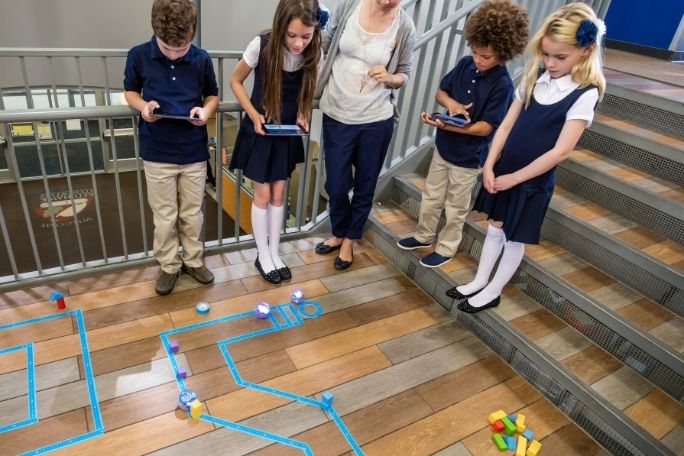Lesson summary
This is a STEAM lesson, which adds the Arts to STEM (Science, Technology, Engineering, and Mathematics). In this lesson, students refine their ideas for a school community robotics event based on feedback from end-users and stakeholders. Students then consider other organisational elements to be completed prior to the implementation of their projects and plan to complete these tasks.
Learning intentions:
Students will...
- develop their ideas for robotics activities based on peer and user-feedback
- prepare for implementation of their robotics project.
Success criteria:
Students can...
- create prototypes to share with others
- adapt their prototypes based on feedback
- organise all resources required for project implementation
- delegate tasks amongst group members
- take responsibility for completing tasks assigned to them.
Lesson guides and printables
Curriculum links
Select your curriculum from the options below.
Lesson details
Curriculum mapping
Australian curriculum content descriptions:
This lesson can be used across multiple curriculum strands in addition to the Maths that have been listed below. In particular, this lesson could also provide opportunities for Digital Technologies and English.
Year 5 Mathematics:
- Solve problems involving multiplication of larger numbers by one- or two-digit numbers, choosing efficient calculation strategies and using digital tools where appropriate; check the reasonableness of answers (AC9M5N06)
- Choose appropriate metric units when measuring the length, mass and capacity of objects; use smaller units or a combination of units to obtain a more accurate measure (AC9M5M01)
- Solve practical problems involving the perimeter and area of regular and irregular shapes using appropriate metric units (AC9M5M02)
- Construct a grid coordinate system that uses coordinates to locate positions within a space; use coordinates and directional language to describe position and movement (AC9M5SP02)
Year 6 Mathematics:
- Recognise situations, including financial contexts, that use integers; locate and represent integers on a number line and as coordinates on the Cartesian plane (AC9M6N01)
- Solve problems involving addition and subtraction of fractions using knowledge of equivalent fractions (AC9M6N05)
- Establish the formula for the area of a rectangle and use it to solve practical problems (AC9M6M02)
- Interpret and use timetables and itineraries to plan activities and determine the duration of events and journeys (AC9M6M03)
Syllabus outcomes: MA3‑1WM, MA3‑2WM, MA3‑3WM, MA3‑6NA, MA3‑8NA, MA3-9MG, MA3-10MG, MA3-11MG, MA3-12MG, MA3-16MG, MA3-17MG, EN3-1A, EN3-2A, EN3-8D
General capabilities: Literacy, Numeracy, Digital Literacy, Critical and Creative Thinking, Personal and Social Capability.
Cross-curriculum priority: Sustainability.
Relevant parts of Year 5 Mathematics Achievement Standards: Students use their proficiency with multiplication facts and efficient calculation strategies to multiply large numbers by one- and two-digit numbers and divide by single-digit numbers. They choose and use appropriate metric units to measure the attributes of length, mass and capacity, and to solve problems involving perimeter and area. They estimate, construct and measure angles in degrees. Students use grid coordinates to locate and move positions.
Relevant parts of Year 6 Mathematics Achievement Standards: Students use integers to represent points on a number line and in the Cartesian plane. Students order common fractions, giving reasons, and add and subtract fractions with related denominators. They choose and use appropriate metric units to measure the attributes of length, mass and capacity, and to solve problems involving perimeter and area. They estimate, construct and measure angles in degrees. Students use grid coordinates to locate and move positions.
Unit of work: Learning Robotics – Years 5 & 6
Time required: 120 mins
Level of teacher scaffolding: Medium – some students may require support to sort and analyse their findings
Resources required
- device capable of displaying video to class
- Student Worksheet (one copy per students)
- Sphero SPRK+ (or alternative programmable robot), minimum one per 3 students
- device capable of running Sphero Edu App, e.g. iPad, iPod Touch (or required software for your robot), one for each robot
- variety of reusable construction materials and additional equipment to create contexts/challenges for robots (e.g. Duplo, blocks, rulers, tennis balls, small hoops, etc.)
- enough copies of the Student Progress Resource to list all students or groups in the class.
Skills
- collaboration
- communication
- community engagement
- creativity
- critical thinking
- digital literacy
- enterprise
- problem solving
- social skills.
Additional info
This is an original Cool+ lesson.


Welcome back!
Don't have an account yet?
Log in with:
Create your free Cool.org account.
Many of our resources are free, with an option to upgrade to Cool+ for premium content.
Already have an account?
Sign up with:
By signing up you accept Cool.org's Terms and Conditions(Opens in new tab) and Privacy Policy(Opens in new tab).